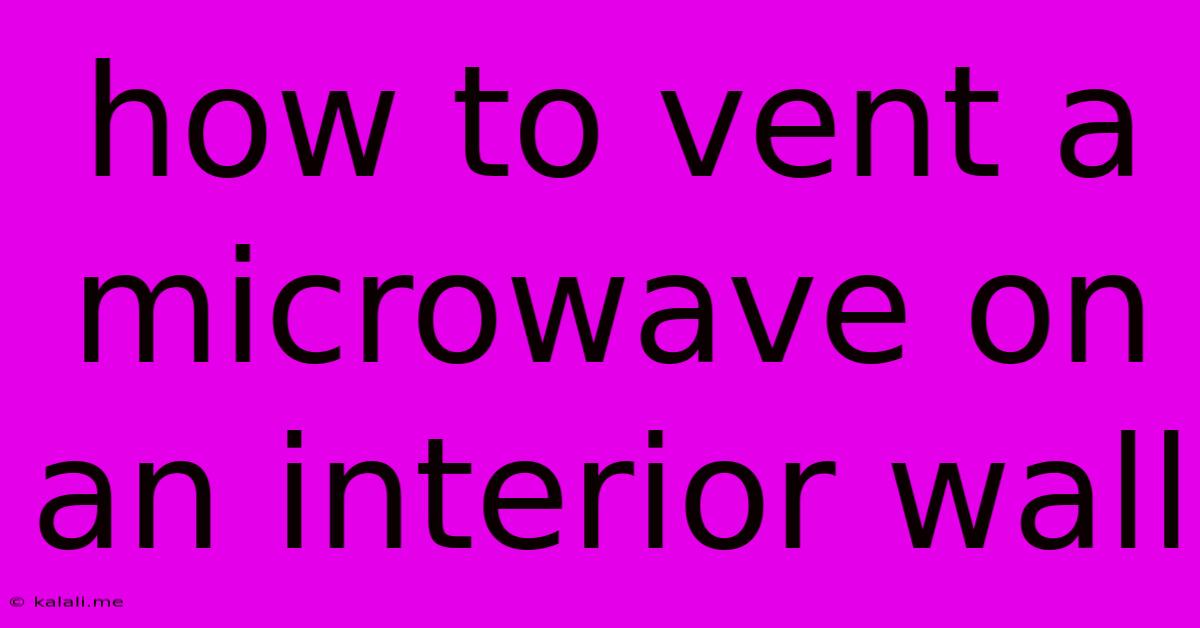How To Vent A Microwave On An Interior Wall
Kalali
May 25, 2025 · 3 min read

Table of Contents
How to Vent a Microwave on an Interior Wall: A Comprehensive Guide
Meta Description: Vent a microwave on an interior wall safely and effectively with this comprehensive guide. Learn about necessary components, installation steps, and crucial safety precautions. Avoid costly mistakes and ensure proper ventilation for your kitchen.
Microwaves, especially powerful ones, generate heat and moisture during operation. While many countertop models don't require venting, built-in or over-the-range models often necessitate proper ventilation to prevent moisture buildup, damage to cabinets, and potential safety hazards. Venting a microwave on an interior wall presents a unique challenge, requiring careful planning and execution. This guide provides a step-by-step approach to ensure a safe and effective installation.
Understanding the Challenges of Interior Wall Venting
Venting a microwave on an interior wall differs significantly from exterior wall venting. Instead of directly expelling air outside, you'll need to route the vent through the interior of your home. This means considering:
- Airflow: You need to ensure sufficient airflow to remove moisture and heat efficiently. A poorly designed system can lead to condensation, mold growth, and even damage to your microwave.
- Space Constraints: Interior wall venting often requires navigating existing wall structures, electrical wiring, and insulation. Careful planning and potentially some demolition work might be necessary.
- Aesthetics: The vent's appearance within your kitchen is crucial. You'll need to consider how to seamlessly integrate the venting system into your existing design.
- Code Compliance: Always check your local building codes and regulations regarding microwave venting and interior wall modifications.
Essential Components for Interior Wall Microwave Venting
Before starting, gather the necessary materials. These might include:
- Microwave with a vent: Ensure your microwave model is designed for venting and check the manufacturer's instructions.
- Ventilation Kit: This typically includes a duct, vent hood, and connectors. Choose a kit sized appropriately for your microwave’s CFM (Cubic Feet per Minute) rating. Higher CFM ratings generally indicate more powerful ventilation.
- Flexible Ducting: This allows for maneuvering around obstacles within the wall cavity. Consider using rigid ducting for a more efficient system, but be aware of the complexities of navigating bends and angles.
- Wall Plates and Grilles: Choose aesthetically pleasing wall plates and grilles that match your kitchen's design.
- Tools: Measuring tape, drill, saw (if needed for cutting wall sections), screws, and potentially a stud finder are essential.
Step-by-Step Installation Guide
1. Planning and Design: Carefully plan the vent route, considering the shortest path and avoiding obstacles like electrical wiring and plumbing. Mark the location of wall openings for both the microwave and the vent outlet on the opposite wall or ceiling.
2. Cutting Wall Openings: Precisely cut the necessary openings in the walls, ensuring they are the correct size for the vent components. Remember to switch off power to any electrical circuits in the affected area before drilling or sawing.
3. Installing the Ductwork: Carefully route the flexible or rigid ducting through the wall cavity, ensuring secure connections between all components. Use appropriate sealant to prevent air leaks.
4. Installing the Vent Hood: Attach the vent hood securely to the wall, ensuring it aligns properly with the ducting.
5. Connecting to the Microwave: Connect the microwave's exhaust vent to the ducting system, following the manufacturer's instructions.
6. Testing the System: Before sealing the wall openings, test the system by running the microwave at its highest setting. Ensure proper airflow and check for any leaks.
7. Finishing Touches: Securely install the wall plates and grilles to conceal the ducting and complete the installation.
Safety Precautions
- Electrical Safety: Always switch off power to the affected area before starting any work involving electricity or wall modification.
- Fire Safety: Ensure the ducting system is properly sealed and does not present a fire hazard.
- Moisture Control: Proper ventilation is crucial to prevent condensation and mold growth.
- Professional Help: If you are unsure about any aspect of the installation, consider consulting a qualified professional.
By following these steps and prioritizing safety, you can successfully vent your microwave on an interior wall, ensuring efficient ventilation and a safe and functional kitchen. Remember to always prioritize safety and consult professionals when needed.
Latest Posts
Latest Posts
-
Does A Pb And J Sandwich Need To Be Refrigerated
May 25, 2025
-
What Does Ot Mean In Texting
May 25, 2025
-
How Long Will Tuna Salad Last In Fridge
May 25, 2025
-
How To Remove A Sheared Screw
May 25, 2025
-
How Much Does A Cubic Foot Of Water Weigh
May 25, 2025
Related Post
Thank you for visiting our website which covers about How To Vent A Microwave On An Interior Wall . We hope the information provided has been useful to you. Feel free to contact us if you have any questions or need further assistance. See you next time and don't miss to bookmark.